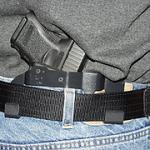Supreme Court: Concealed Carry May Be Next

Another Supreme Court decision may soon send shock waves. It’s the first time the justices will rule on what the Second Amendment means since 2010.
For centuries, the Second Amendment was construed as referring to service in the militia. It wasn’t until 2008 in District of Columbia v. Heller that the Court established an individual right to gun ownership. The decision was the culmination of a decades-long campaign by the National Rifle Association and other gun rights allies, as I wrote in my book The Second Amendment: A Biography. (Two years after Heller, in McDonald v. City of Chicago, the Court forbade states, not just the federal governments, from infringing on the gun ownership rights recognized in Heller.)
The Supreme Court has not made a major Second Amendment ruling since 2010. Meanwhile, hundreds of judges around the country developed a robust approach to the Second Amendment, as my Brennan Center colleague Eric Ruben has documented. Yes, they have ruled, it is an individual right, but like other individual rights, there can be restrictions based on society’s needs, such as public safety. The judges borrowed an approach from the First Amendment known as “tiered scrutiny.” The vast majority of gun laws were upheld.
Now there’s a new Supreme Court supermajority of six justices. The NRA is bankrupt and discredited, but its political power lives on in the lifetime-tenured justices, many of whom the organization pushed into power. This case is the result.
New York State Rifle & Pistol Association Inc. v. Bruen challenges a 1913 New York law limiting who can carry a concealed weapon in public places. In order to get a concealed carry license, New Yorkers must show that they have “proper cause” — basically a greater need for self-protection than others in the community. The law’s challengers contend that the Second Amendment guarantees them the right to carry a concealed weapon without the permission of a licensor.
At the oral argument, Justice Samuel Alito asked New York State’s lawyer a startling question: “There are a lot of armed people on the streets of New York and in the subways late at night right now, aren’t there?” Alito added, “All these people with illegal guns: they’re on the subway, walking around the streets, but ordinary, hardworking, law-abiding people, no. They can’t be armed.”
The suggestion that anyone would want subway riders to be carrying guns is absurd. Perhaps the justice is spending too much time in his basement watching 1970s Betamax tapes of The Warriors or Death Wish. That dystopian depiction of the transit system hasn’t been the reality in decades, if ever. Indeed, in Essex County, New Jersey — where Alito grew up, population approximately 800,000 — there were more than 150 shootings last year. Comparatively, the subway system recorded just three in the same time frame, while moving hundreds of millions of passengers.
The idea that “ordinary, hardworking, law-abiding people” should show up armed on a subway, or a college campus, or for that matter a city street, is utterly at odds with the real world and real life as real people actually live it. But this Court, drenched in dogma and originalist faux-history, may force that on cities all across the country.
Perhaps they will rule that cities can bar guns from unusually dangerous places. (The argument spent a surprising amount of time on the question of whether the campus of the NYU School of Law was, in fact, a campus, or was too groovily urban to be seen that way.)
Some observers expect Justice Clarence Thomas to write this opinion. He has repeatedly decried the Court’s unwillingness to blow up gun laws. He thinks that there should not be First Amendment-style scrutiny but rather a sole focus on “text, history, and tradition.”
Fortunately, there is much “history” and “tradition” that supports restrictions on carrying weapons. We may hear Hollywood-infused ideas of “law-abiding people” packing heat. In fact there’s a striking photo from Dodge City, the legendary frontier town. It shows a sign planted in the middle of its main street: “The Carrying of Fire Arms Strictly Prohibited.”
Bruen may be a bigger case than Heller. Only a handful of American cities had DC-style bans on handguns inside the owner’s home, so the Heller decision didn’t touch most of the country. In contrast, eight heavily populated states have concealed carry laws similar to the one at issue in Bruen. If the Court strikes down New York’s law, roughly one-quarter of Americans can expect to interact with people carrying deadly weapons.
The Supreme Court could issue a more limited ruling in Bruen, for example rescinding the “proper cause” requirement of the New York law without declaring an absolute constitutional right to concealed carry. But recent history suggests these justices aren’t interested in limited rulings. Watch out for falling precedents.
Remember what Justice Antonin Scalia, who wrote Heller, said of his colleague Clarence Thomas. When asked about the difference between their jurisprudence, Scalia replied, “I am a textualist. I am an originalist. I am not a nut.”
Michael Waldman is president of the Brennan Center for Justice at NYU School of Law. A nonpartisan law and policy institute that focuses on improving systems of democracy and justice, the Brennan Center is a leading national voice on voting rights, money in politics, criminal justice reform, and constitutional law. Waldman, a constitutional lawyer and writer who is an expert on the presidency and American democracy, has led the Center since 2005.
